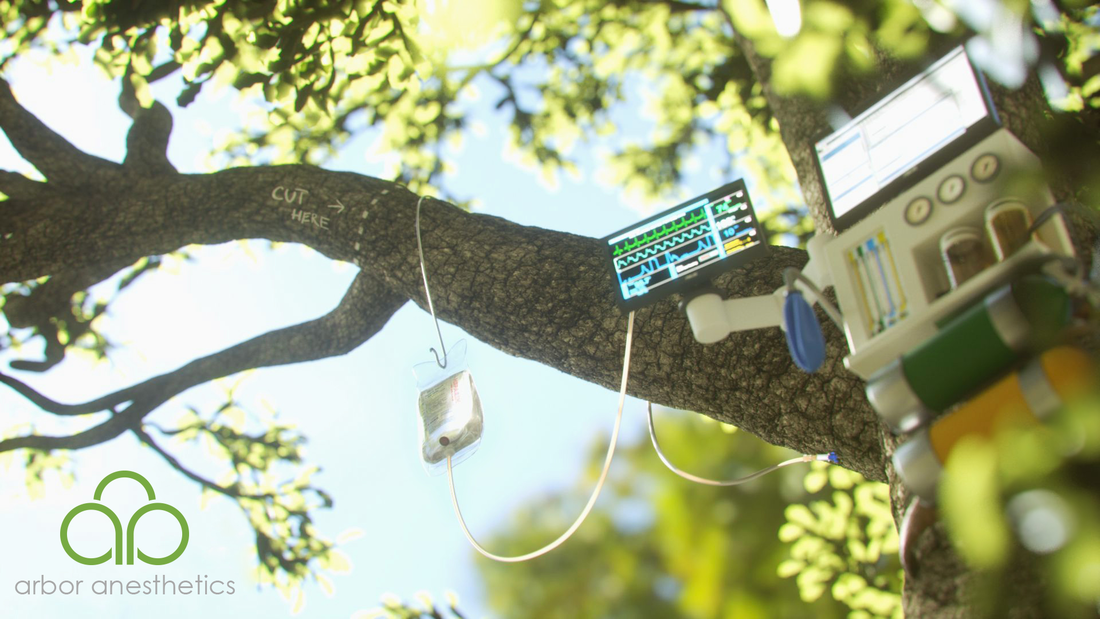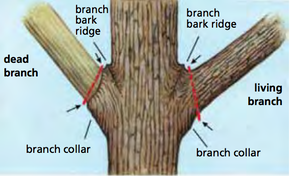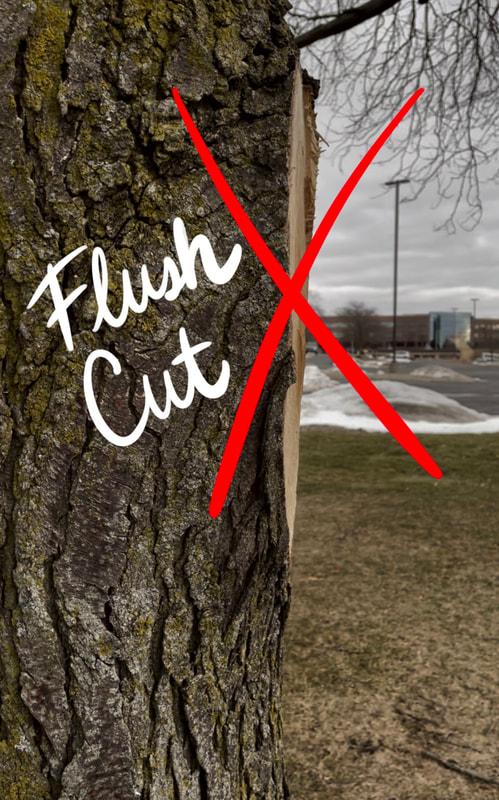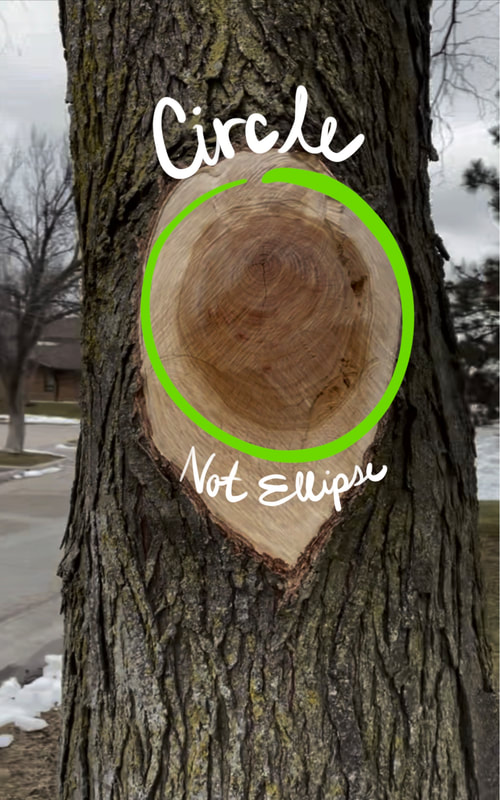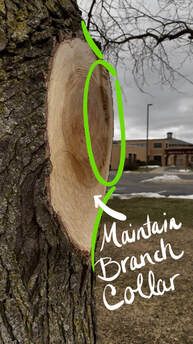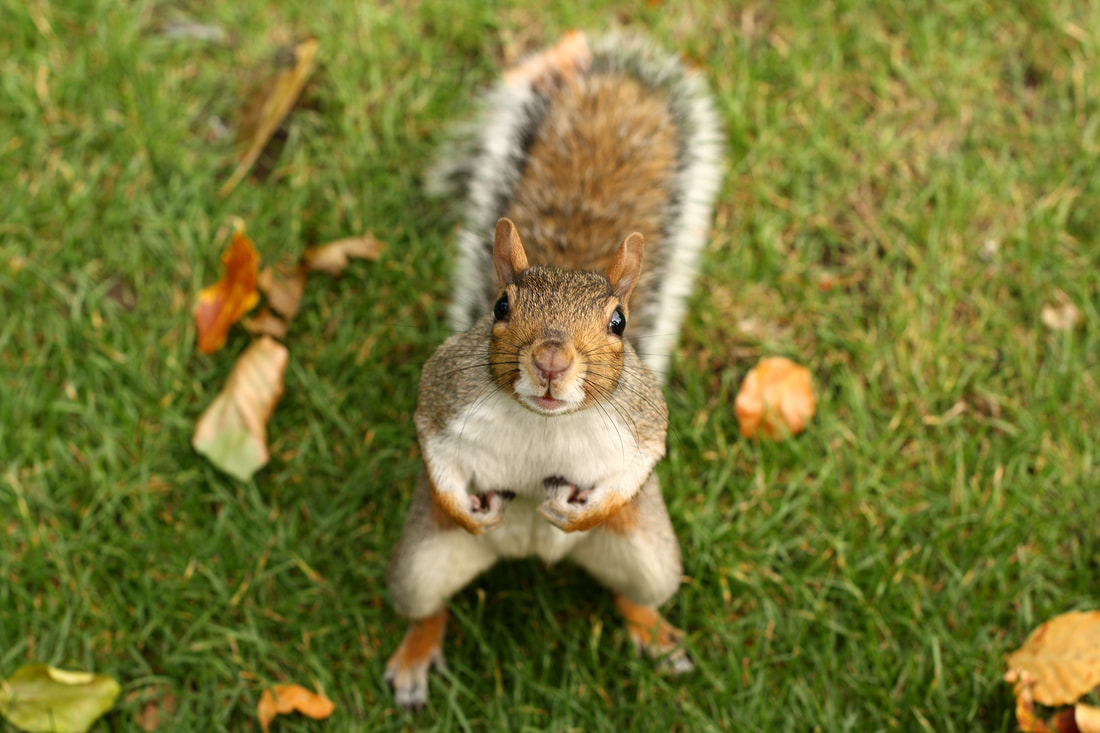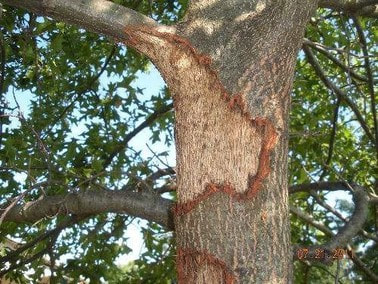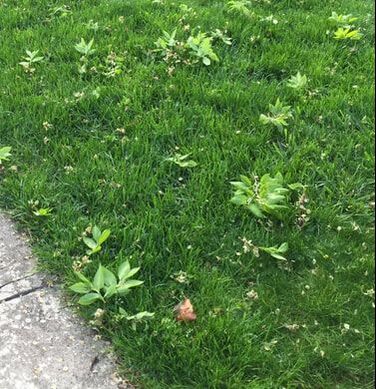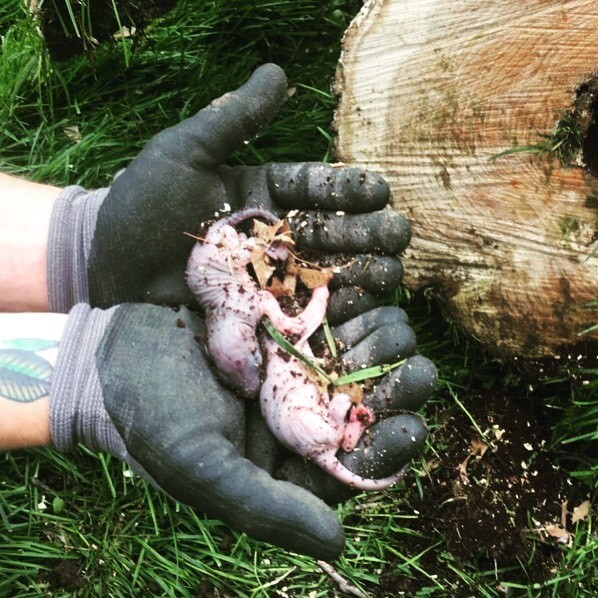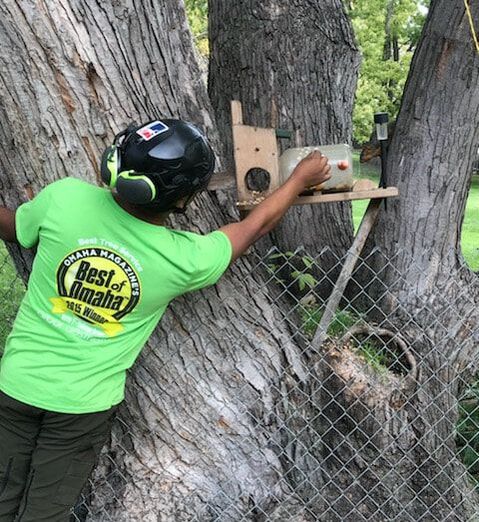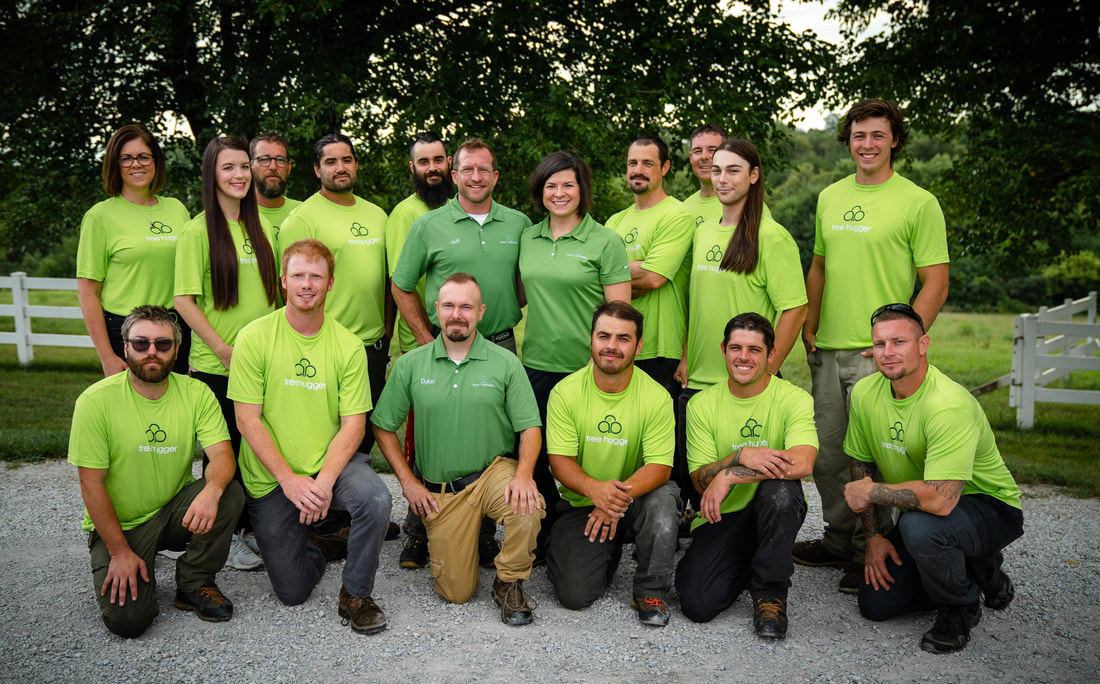Arbor Anesthetics – Innovative Pain Management Solutions for Tree Pruning
Here are FIVE ways you can prevent harm to your trees:
- Flush Cuts – Improper Pruning Techniques
- Mulch – but not too much!
- Will cutting into a tree’s roots harm the tree?
- DIY Tree Pruning
- Tree Topping Hurts
Don’t fool around with your trees! Hire a professional, Certified Arborist, like Arbor Aesthetics Tree Service!
Flush Cuts – Improper Tree Trimming Techniques
Trees have a response to wounding, coined “Compartmentalization of Decay in Trees” or “CODIT.” A tree “walls” off decay in four layers of bark tissue, preventing decay from moving vertically, radially and tangentially. When a wound occurs naturally, the tree gets to work using its own defense mechanism to keep decay-causing fungi from spreading. When a wound occurs during routine tree pruning (yes – it’s a still a wound!), a trained arborist can take steps to ensure the tree is given its best shot at using its CODIT system.
Maintaining the branch collar is critical in tree pruning and allows the tree to form a proper callus around the wound. The illustration to the right shows a clear swelling of tissue at the branch collar as the tree is preparing to shed a dead limb naturally. Trees know what they’re doing! When we prune live limbs, we can use this as a model for where to make our cut – by not cutting into the branch collar. The branch bark ridge is not always obvious, and when it is not easy to identify the collar, we consider it best practice to come away from the trunk slightly. It would be better to leave more of a stub than it would be to cut into the branch collar.
In general (and certainly not in all cases), a proper pruning cut will result in a circular wound or as close to a circle as possible. In the photos, you can see the elliptical shape of the cut where the flush cut was made parallel to the trunk, but not perpendicular to the branch, resulting in a vertical ellipse where we can see the branch collar was removed.
If you are unsure where you make a proper pruning cut, it’s best to consult a certified arborist. You can read more about DIY Pruning in a previous blog post.
- Compartmentalization of Decay in Trees, Bartlett Tree Experts
https://www.bartlett.com/resources/compartmentalization-of-decay-in-trees.pdf - University of Iowa Extension & Outreach
https://hortnews.extension.iastate.edu/faq/when-pruning-trees-it-desirable-make-flush-cuts#:~:text=Flush%20cuts%20are%20pruning%20cuts,collar%20and%20branch%20bark%20ridge.
Arbor Aesthetics Tackles Accreditation with Virtual Audit – Tree Care Industry Association Magazine
|
We are honored to be featured in the March 2021 issue of the Tree Care Industry magazine. Every March, the association dedicates the issue to the incredible leading women of the industry. This year, nine articles (over 40 pages!) featured women, which is a big deal for a male-dominated industry.
As everyone in tree care faces the challenges of working through a pandemic, some businesses actually seem to be thriving, as is the case with Arbor Aesthetics Tree Service, a seven-year TCIA member company based in Omaha, Nebraska. Certified Arborists and co-owners Amy and Jeff Grewe have watched their business grow exponentially over the past year, prompting them to make the decision to pursue TCIA’s Residential/Commercial Accreditation during an already busy and challenging season.
The couple met in 2013, the first year Jeff’s young tree care company became a TCIA member. “I knew nothing about trees when I met Jeff,” Amy notes. “He said he was a climber – I didn’t know climbing trees was even a profession! “My education is in graphic design, but I also had several years of bookkeeping experience,” she continues. “In 2014, I saw a bill from his accountant’s office, and I remember thinking, ‘Wow, that’s more than I make in a year!’ So we made the decision that I would quit my job and come on board full time in his office. I looked at his office processes, which were virtually non-existent, and I also started answering his phone during business hours for the first time ever, since he was always out working with his crew during the day.” Amy and Jeff were married in 2015 – “We were business partners before we were married,” she says with a laugh – and Amy became a Nebraska certified arborist in 2016. “I found I really enjoyed talking to customers about trees, but I needed to know what I was talking about. Jeff and I went to classes and workshops together, and I’ve grown to love being part of the industry. Tree people are good people, intelligent and caring.” As a woman co-leading a tree care company, Amy says she brings a unique perspective to the business. “I think I’ve been an organizational asset for sure,” she explains. “Also, I think women have a knack for anticipating people’s needs and managing people’s expectations, which plays into providing excellent customer service. I definitely brought a shift to a customer-centric approach to the business.” Amy also talks about instituting the company’s “Gift of Beautiful Trees” program, which she and Jeff launched in 2015. Every year since then, the couple has chosen a deserving family to receive up to $3,000 in tree-trimming and/or removal services. “Proper tree care can be expensive for the average person,” Amy explains, “so we began asking for nominations of families or neighbors who might not have room in their budget for tree care. It’s really amazing to me that something as simple as trimming or removing a tree can provide so much hope and change the trajectory of someone’s life when they are living through a challenging season. It lets people know that their community is there for them in their time of need. They feel seen.” An important aspect of Arbor Aesthetics becoming accredited was instituting a formal training program. Now every new hire is put with a crew leader they can go to if they have questions and who becomes their mentor. This may be one of the reasons Omaha Magazine has named Arbor Aesthetics Tree Service as its “Best of Omaha” tree service for the sixth consecutive year. When it came time to consider Accreditation, Amy relates that the process happened in fits and starts. “We first looked into Accreditation at the 2015 Winter Management Conference in Cabo,” Amy explains. “But then we got married right after Winter Management and had a baby the next year, and I just didn’t have the time I knew it would take to devote myself to doing it right. When we started growing and getting really busy, I knew we needed to have more processes in place or this whole thing was going to fly off the tracks. “I’m not going to sugarcoat it – I was totally overwhelmed when I first looked at the process. But I put up a huge white board in the office and broke it out into tiny, tiny pieces, so that every day I could check something off the list and maintain momentum. “A good friend of ours, Joseph Eves at Coastal Tree Care in San Diego, also is accredited, and he told me I had to find a way to enjoy the Accreditation process. Can you imagine?” Amy says with a laugh. “I’m very detail oriented, so the biggest hurdle for me was to realize that it was better to call it done than to strive for perfection.” According to Amy, who says it was about six months of “pedal to the metal” to complete the process, implementing a safety program was the biggest challenge. “I really wanted it to be specific to our company, not just something adopted from someone else’s program. Not having field experience made it especially challenging to me. I would ask Jeff my safety questions, and he would help me figure out what I needed. As a result of Accreditation, we realized we had a dire need for a safety director, and Matt Horan got his CTSP credential as a result and was more than happy to step into that role.” Arbor Aesthetics now has what Amy calls a “peer-to-peer safety program” with weekly safety tailgate meetings led by crew members. One artistic team member drew comics illustrating the topic of distracted drivers, and another put together a PowerPoint on the subject of aerial-lift safety. “We think the best way to learn is by teaching,” Amy notes. Another important aspect of becoming accredited, according to Amy, was instituting a formal training program. “We found this particularly helpful. Now every new hire is put with a crew leader, so they know who to go to if they have questions. The crew leader becomes their mentor, and they are given expectations from the get-go.” Jeff Grewe with one of the company vehicles. DOT compliance was one of the areas Arbor Aesthetics was able to improve on as part of the Accreditation process, according to Amy Grewe.Her biggest surprise, notes Amy, was the section pertaining to CDL drivers. “I didn’t know anything about DOT random drug-testing requirements, and that part was sort of confusing to me. We also weren’t compliant with the DOT’s daily vehicle inspections – that part was new to me. Now everything is documented. I have no doubt that the documentation we have now could potentially save lives.” Arbor Aesthetics was one of the first companies to go through a virtual audit process, which Amy says went quite smoothly. “We had about a two-hour Zoom meeting. I think I was probably over prepared, but that’s just my personality. I also needed to send photos of things like proper aerial-lift use, climbers having two tie-in points, proper PPE and safe roadside setup.” When asked whether she thinks Accreditation is of value, Amy notes, “Anyone who is uncertain whether becoming accredited is a good investment should know that the return on your investment of time and energy will pay itself back in dividends. We should have implemented a lot of these things years ago. This is an opportunity to step back, zoom out and look at how all aspects of your business are working, or not working, together. It’s an opportunity to design your company again from the ground up and put it to paper. “I see an attitude shift in our company in that we’re doing these things not just to check boxes,” she continues. “We see the big picture, and we value the processes that have been put in place to hold each other accountable, protect each other, communicate our vision across the organization and ultimately provide an unbeatable experience that our clients can feel and appreciate.” |
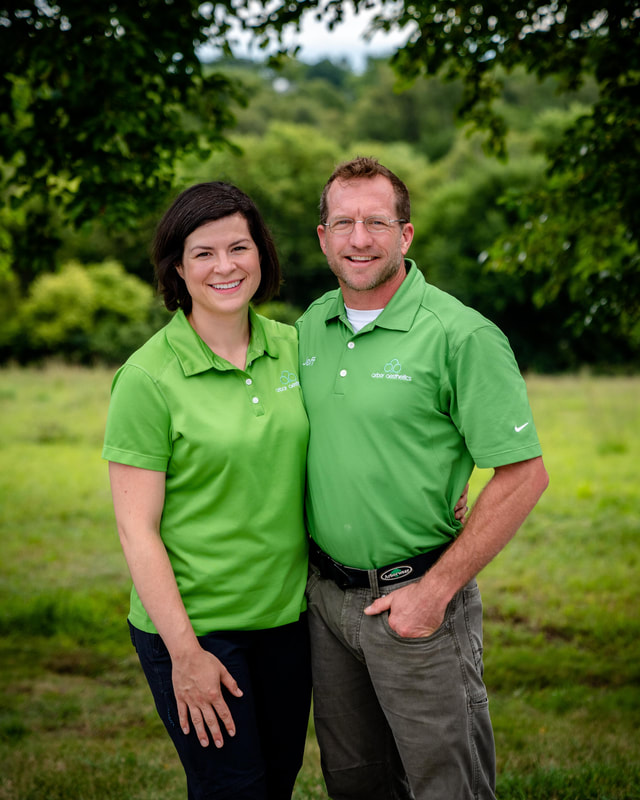
Jeff & Amy Grewe, owners
|
Squirrels & Trees, Love & Hate.
|
Today is Squirrel Appreciation Day! Squirrels are easy to love for their cunning personalities and cuteness, but they can just as easily become a nuisance when they turn to your trees for nutrition and habitat. Nevertheless, squirrels play an important role in our ecosystem and we can learn to coexist in harmony!
|
Bark stripping
Research indicates that bark stripping has a higher occurrence following a “mast year” where trees produce a bumper crop of fruits and seeds, which may correlate with a higher population of juvenile squirrels. Here is an excellent article from Ohio State University about bark stripping.
EATING TREE BUDS
tree trimming to protect young squirrels
|
In the United States, it’s best to trim your trees between November and January to avoid nesting seasons. Of course, if the tree trimming must take place during nesting, our arborists are careful not to disturb nests. Plenty of foliage should be left around the nests for their protection from predators and the elements.
Keeping squirrels out of your houseAre squirrels finding their way into your home? They can easily jump up to 10 feet from a tree onto your roof and find their way into attics, crawl spaces and chimneys to seek warmth and protection. Let your arborist know if your objective is to prevent this from happening and your tree can be trimmed to clear the house by more than 10 feet. Of course, our best advice is to find where the squirrels are entering and secure the openings.
|
Did you miss our previous article…
https://www.treesforeducation.com/?p=141
Arbor Aesthetics Featured in Midland’s Business Journal
|
Check us out in the Midlands Business Journal talking about our growth in 2020 and our future plans. Regarding our customer experience, Jeff says, “From the first phone call into the office to the last twig raked from the yard, it is a beautiful experience because it is just so unbelievably the way it is supposed to be. It is friendly, it is timely, and there is communication all the way through.”
READ HERE: 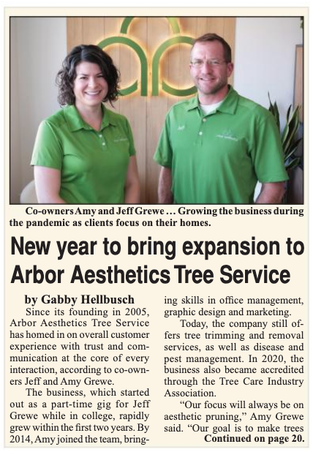
|

|
Did you miss our previous article…
https://www.treesforeducation.com/?p=137
Arbor Aesthetics earns Accreditation by the TCIA
|
OMAHA TREE CARE COMPANY BECOMES SECOND IN NEBRASKA TO EARN ACCREDITATION
Program helps consumers find high-quality tree care companies Arbor Aesthetics Tree Service, a residential tree care company located in Omaha, Nebraska has been accredited under a new Tree Care Company Accreditation program administered by the Tree Care Industry Association (TCIA) and built on the threefold foundation of ethics, quality, and consumer confidence. The new program represents the only business practices and compliance audit process in the tree care industry. Under the process, businesses undergo extensive review of professional practices aimed at safeguarding consumers. The review includes: ► best business practices ► ethical business conduct ► formal training and certification of employees ► compliance with industry standards ► consumer satisfaction ► adherence to safety standards ► insurance coverage TCIA Accreditation means Arbor Aesthetics adheres to all the accreditation standards and has undergone a rigorous application process. TCIA verified this by conducting an on-site audit of Arbor Aesthetics. TCIA Accreditation for Arbor Aesthetics is in effect for a period of three years, with renewal check-ups required every year. The annual renewal ensures that the required number of certified arborists are still on staff, that the company is still properly insured and that the company has a good safety and consumer satisfaction rating. The company is re-accredited every three years. According to TCIA president Mark Garvin, “TCIA Accreditation provides consumers a way to find tree care companies that are trustworthy in their business and tree care practices. Our TCIA Accreditation program is the only one of its kind in America and will give consumers peace of mind.” The process of becoming accredited is no easy task, according to Amy Grewe, President. “The process is incredibly thorough. They left no stone unturned,” states Grewe. “Jeff and I are pleased that in our 15th year in business, we have finally been recognized as one of the best tree care companies around, joining only one other accredited company in Nebraska. Garvin echoes that sentiment. “Arbor Aesthetics has made a commitment to excellence in all facets of its business. I applaud their efforts.” |

|
What is the best mulch to stop weeds?
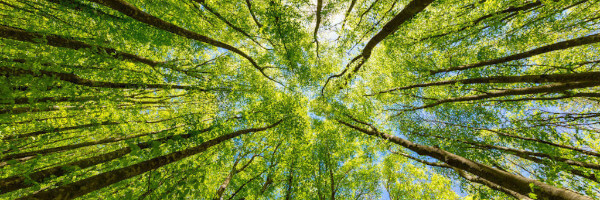
Maintaining a garden is a labour of love. But sometimes the time and effort involved can be challenging to keep up. That’s why many homeowners today look for ways to make gardening easier. Low maintenance solutions like automatic sprinklers and composting systems are just the beginning.
One of the most challenging tasks for maintaining a garden involves weed removal. Weeds can be difficult to find and remove. Even when you least expect it, there could be seeds from weeds spreading around your garden beds. These seeds could be laying dormant until conditions are right for them to start thriving in your backyard.
Weeds are often the cause of many frustrations and issues in the garden. To help you manage weeds and keep them under control, let’s explore one of the most effective methods for stopping them—adding mulch to your garden beds.
Why mulch is a great option for weed control
When you apply mulch to your garden beds you are giving your soil a protective layer. A layer of mulch effectively blocks out the sunlight and prevents it from hitting your garden’s soil. Keep this in mind as we go through how weeds end up in your garden.
Weeds tend to spread when their seeds drop and get deposited into the soil. They can quickly multiply and spread throughout your garden in no time when growing conditions are favourable for them. Luckily, one of the most essential ingredients that help the seeds of a weed grow is nourishment from the sun.
So if you effectively block out sunlight hitting your soil, you take away a major food source for the seeds of the weeds to grow. Photosynthesis can longer occur which helps give weeds the nourishment they need to grow.
How mulch can help other plants thrive
One of the major benefits of laying down mulch is the protection it provides for the rest of the plants in your garden beds. During hot and dry seasons, mulch can help retain moisture in your soil. So long after your garden beds have been watered, the mulch will retain water and keep the soil moist.
This moist environment underneath your mulch will continue to help your plants thrive in more ways than one. Mulch can also help regulate temperature. In colder climates, the mulch is also effective at retaining heat. This form of temperature control contributes to a warm environment that helps your plants thrive well before Spring kicks in.
By now you’re probably wondering why mulch doesn’t hamper the growth of your other plants if that’s what it does to weeds. The truth is, you have to have well-established plant seedlings in place before laying down mulch. This ensures your seedlings sit above the mulch so they can still absorb nutrients and energy from the sun via photosynthesis.
Mulching on a budget
Your gardening budget can definitely help you narrow down your options for garden mulch. If you don’t want to fork out money for it, there are several free options you can rely on. If you regularly prune your garden you may already have a collection of twigs and small branches lying around. These can be perfect options for your garden mulch.
Fallen leaves from the trees in your yard are also a great option. But depending on the type of leaves you choose they may compost a lot faster than your standard mulch. Other free options to consider are sawdust or wood chips leftover from any work you’ve done in the garage. If you own a big lawn at home you may also appreciate that grass clippings from lawn mowing can also be used for mulch.
Choosing the best mulch for your needs
Choosing the best mulch to stop weeds in your garden really depends on your maintenance needs and what you’re trying to grow in your individual garden beds. Ideally, you want a mulch that can block out light from your soil. That’s the most important thing to consider when choosing the best mulch to stop weeds.
The free options we mentioned earlier like leaves and grass clippings are great but they can decompose a lot faster than other varieties. Wooden chips and mulch are popular options for several reasons. They don’t decompose quickly. They can last for months or well over a year before they start to deteriorate. One of the disadvantages of wooden mulch and chips is that because they don’t break down as fast, they won’t enrich your soil and provide your plants with nutrients.
A great solution we’ve found is using a combination of compatible mulch like leaves, grass, and hay with wooden mulch laid on top of it. This option gives you the best of both mulches. You’ll get the nutrients from the breakdown of leaves and other organic matter combined with the long-lasting surface protection of wooden mulch.
Get your next batch of garden mulch from Daryl’s tree care
Do you have a few trees that need to be removed from your garden? If so, we’ve got some great news for you. These trees can be turned into mulch that you can use directly in your garden. As part of our tree removal service, we offer mulching. So the branches, tree stump and log from your tree can be placed straight into our wood chipper where it’s turned into wooden mulch.
Even if you’re not getting any tree removed, we can still supply and deliver tree mulch straight to your yard. But you will have to be patient. Our wooden mulch only becomes available for jobs that require trees to be processed through a wood chipper.
So contact us today and we’ll gladly let you know when the next load of wooden mulch will be available for you to buy. Leading up to the day when we process a tree, we’ll let you know and arrange a day and time for your mulch delivery.
The post What is the best mulch to stop weeds? appeared first on Daryl's Tree Care And Surgery.
